King of Clubs
Richard Wolf of the Tao Group discusses the importance of creating wows and
moments, how copying can be a cop-out, and his famous red wine test.
 By Stacy Shoemaker Rauen
By Stacy Shoemaker Rauen
Richard Wolf has had a busy year. In September, he and his TAO Group partners Marc Packer, Jason Strauss, and Noah Tepperberg brought their successful Las Vegas restaurant and nightclub LAVO to New York, housed in a space directly across the street from the original TAO. Then on New Year’s Eve, they transported über-successful New York nightclub Marquee to the Cosmopolitan of Las Vegas and added a pool dayclub component for a total of 60,000 square feet. Last month they opened multiple new venues in the much-anticipated Dream Downtown in New York from Vikram Chatwal Hotels/Hampshire Hotels & Resorts and Wyndham. The highlight-a rooftop lounge with heady city views. But that wasn’t enough for Wolf. With his other set of partners, Chris Santos and Peter Kane, he opened the sequel to Stanton Social, restaurant and lounge Beauty & Essex on New York’s Lower East Side, just a few weeks before Marquee opened. He took time from his hectic schedule to discuss the importance of creating wows and moments, how copying can be a cop-out, and his famous red wine test.
Click here to see images of TAO Group’s latest work at Dream Downtown.
 HD: Why did you want to bring LAVO to New York? A location across the street from TAO is kind of serendipitous since both TAO and LAVO in Las Vegas are in the same hotel complex.
HD: Why did you want to bring LAVO to New York? A location across the street from TAO is kind of serendipitous since both TAO and LAVO in Las Vegas are in the same hotel complex.
RW: Typically, restaurants and clubs in Vegas start somewhere else-LA, New Orleans, Chicago, New York-and then they open in Vegas. It’s rare that it’s the other way around. The thing about Vegas is that everything is kind of fake. We’re all from New York, every one of us. So we feel that when we do something in Vegas, what Vegas really needs is authentic New York.
LAVO Las Vegas’design is more downtown New York than most other places in town, with the exception of maybe TAO. And it just really seemed like a natural. We started in Vegas, now let’s break the mold and do the reverse. We always knew that opening a LAVO in New York would give a shot in the arm to Las Vegas, and there would be some great synergy. When we opened up TAO Las Vegas, TAO New York spiked 20 percent in sales.
HD: Was that the same reason to bring Marquee to Las Vegas?
RW: Let’s just say that in the last 10 to 12 years in New York there’s been two top clubs. Lotus was the first, and then Marquee. So to achieve that status, to own the hottest nightclub in New York for roughly seven years, which is forever in club years, [is impressive]; it’s equivalent to a 25-year run. And while there’s really no club in the history of New York that has ever just gone on and on, it just seemed like the perfect brand, for lack of a better way to say it. The first time it got mentioned, Marc, myself, Noah, and Jason went out to dinner with the CEO, CFO, and general manager of the Cosmopolitan. It’s the first time somebody said, ‘What about Marquee?’I think Noah said it. And John Unwin, the CEO, is like, ‘I love the idea of Marquee.’And we all just thought, ‘Oh, wow, it’s time for the next incarnation of Marquee.’Because to see a brand like Marquee just go off into the sunset and never to be heard from again was a bit of a crime. Like Lotus is gone. It had its run, it had its day, and now it’s gone. Marquee lives on.
 HD: Beauty & Essex was opening in New York in the middle of all this, with your other partners, Chris Santos and Peter Kane. You’ve got Stanton Social around the corner, which is extremely successful. Was this to build on that success?
HD: Beauty & Essex was opening in New York in the middle of all this, with your other partners, Chris Santos and Peter Kane. You’ve got Stanton Social around the corner, which is extremely successful. Was this to build on that success?
RW: That’s exactly what that was. Time Café was my first restaurant, club/lounge, performance space, and Peter was the manager of Fez in Time Café. And Chris was at the time the sous chef, and eventually became the executive chef. I left to open Angelo & Maxie’s in ’96; sold my shares in Time Café in ’98, but we remained friends. I called him them up one day and I said point blank, ‘I think we should do a restaurant together, the three of us. But I’m not in this for one restaurant. I want to make a verbal commitment that we do a minimum of three restaurants together.’And that was done on a handshake, and so Beauty & Essex is the second. We really haven’t started talking about the third yet. We had a very clear vision of what Stanton Social was going to be when we started.
HD: Was that the same for Beauty & Essex?
RW: We did not have that same vision on Beauty & Essex. We struggled. The easy way out would be to open another Stanton Social on the Upper West Side. We would do great business up there-everybody always complains there’s no place to eat up there. But it seemed like a cop-out. The three of us are all very creative people in our own right. Together we can do great things, and while it would be easy, and it would make money, it would also kind of cheapen our brand and who we are. I think that I would rather go through the pain, and there is a lot of pain in a brand new concept. It’s so much work because everything is new-the graphics, napkins, silverware, uniforms, the menu. It’s really, really painful. That’s why opening LAVO was easy for us in New York, relatively speaking. Opening Marquee, I don’t know if I would say it was easy, but when the logo, the name, and the menus, all of the things you spend time developing, when it’s all out of the way and you don’t have to think about that, [it’s easier]. Beauty & Essex was every single thing, down to the hand dryers in the bathrooms. But it’s better to have a new concept like Beauty & Essex that kind of breaks the mold, I think, than to just simply copy ourselves and go uptown and do another Stanton Social, watering down what we already did. I don’t particularly care for copying what we’ve already done. I mean the design of LAVO New York is completely different than the one in Vegas, night and day.
 HD: Right, you used AvroKO in Las Vegas and ICRAVE in New York. What did you want to create in New York?
HD: Right, you used AvroKO in Las Vegas and ICRAVE in New York. What did you want to create in New York?
RW: The big thing about the people who live on the Upper East Side is that it’s really a pain in the neck to go downtown every time you want something that has brick on the wall or something that’s cool-something that feels like it’s downtown. And our mantra in New York has been when we build a place uptown, we want to bring downtown uptown. And really, Beauty & Essex in a way is like bringing uptown downtown. With LAVO, people were excited to have a nightclub and a downtown-feeling restaurant right around the corner, so they no longer had to travel down to a Keith McNally restaurant. Dinner for 12, and then a table in the club for 12, it’s a lot of work to transport three groups of people. [With the restaurant upstairs and the nightclub downstairs] it really is kind of one-stop shopping.
HD: So you had a clear vision for LAVO, but not for Beauty & Essex though you had the space. How did the concept evolve?
RW: We basically make a night out of it once a week. Chris will go over to my apartment at noon and cook for 10 hours. Peter and I would show up around 10:00 pm, and Peter would bring three really good bottles of wine and a playlist. I have a big open kitchen, so Peter and I sit at the counter while Chris cooks and we crack open the wine. We start doing business and housekeeping, and then we get into the creative part of the evening where the ideas start flowing. We have to write them down because by the third bottle of wine we’re not sure if they’re ridiculous, or if they actually make sense, so we look at them the next day to see if it means anything.
 Since the space is really long and narrow we needed to break it up into pieces, and we also wanted the front to feel like part of the neighborhood. Originally we were going to do a bodega where you could buy lottery tickets, cigarettes, and condoms. Peter, or one of us said, ‘How about a pawnshop?’And then Peter said, ‘What about a pawnshop that specializes in jewelry, and we use jewelry as the design reference?’We were high-fiving each other, like we had hit a grand slam. And off we went.
Since the space is really long and narrow we needed to break it up into pieces, and we also wanted the front to feel like part of the neighborhood. Originally we were going to do a bodega where you could buy lottery tickets, cigarettes, and condoms. Peter, or one of us said, ‘How about a pawnshop?’And then Peter said, ‘What about a pawnshop that specializes in jewelry, and we use jewelry as the design reference?’We were high-fiving each other, like we had hit a grand slam. And off we went.
So everything became about jewelry. We have a section on the menu called Jewels on Toast, and the sides are not sides, they’re Accessories. And so with that as our guiding principle, the cylinders just started to click into place on all fronts.
HD: You brought in AvroKO again for the design. After multiple projects, it must be a pretty seamless collaboration.
RW: It’s a very synergetic relationship. We’re extremely involved, to the point of torturing them. I think all designers would probably prefer to just be let loose, and do their thing. But we look at things from many different angles. We look at it from budget, from durability, from the point of view of replacement. We have what we call the ‘famous red wine test,’where they show us a fabric for a banquette, barstool, or a chair, and somebody takes it home, spills red wine on it, and places a glass that has a red wine ring on the bottom on it over night. Then the next day after it’s dry, we see if it can be cleaned off. We’ll do a spike heeled test, because people have been known in our venues to stand on the chairs and the banquettes, so we try and make sure the material can withstand a puncture from a stiletto. The designer looks at the aesthetic, and we have about seven other criteria that we put it through before we agree to it, because it’s a pain in the ass and expensive to constantly replace things.
 We give them the inspiration and they come up with the ideas. We accept and reject a bunch, but we bring a lot of ideas to the table. I am constantly looking through design magazines; I’ll rip something out. We’re not ones to copy, but we get inspiration from others. ‘What if we did this, but did our own little twist on it?’It’s this constant back and forth of ideas.
We give them the inspiration and they come up with the ideas. We accept and reject a bunch, but we bring a lot of ideas to the table. I am constantly looking through design magazines; I’ll rip something out. We’re not ones to copy, but we get inspiration from others. ‘What if we did this, but did our own little twist on it?’It’s this constant back and forth of ideas.
AvroKO came to us, and they said by way of example, upon researching jewelry we find that there is a lot of jewelry made in the form or shape of a bird, and there are also a lot of birds used for display of jewelry. So hence you see these murals with stitching of huge peacocks and peacock feathers in the dining room.
HD: What are some of the other design highlights?
RW: We are a company of what I call ‘wows and moments.’Not everything has to be a wow, and not everything has to be a moment, but there’s got to be enough wows and moments as you walk through a design of ours that just gets people’s attention. We like to think about getting people’s attention on all fronts. Not just with the food, design, and the service, but the whole picture-music, volume levels, temperature, lighting-every single detail. We want it to be a full-on experience, really one where you almost don’t ever have to leave the building. That’s kind of our thing. At LAVO when you’re done, go to the nightclub. At TAO, you’ve got a nightclub to go to in Las Vegas, and in New York, you’ve got LAVO [across the street]. At Stanton Social you have the lounge to go to, and at Beauty & Essex, you’ve got two bars, a lounge, and you can go shopping in a pawnshop. The idea is that you don’t have to go anywhere else to be entertained. In one building, you can eat, hang, drink, party, you can even dance. And we’re all for it.
HD: What are the wows and moments at Beauty & Essex?
RW: One is the pawnshop. That needed to be a wow. ‘Is there a restaurant around here called Beauty & Essex?”Yeah, it’s right here through the door.” That look of confusion. I’m not sure if that’s a wow or a moment, but it’s somewhere between the two. And we didn’t set the pawnshop up until a few days before our first mock service. For the second one, I knew that right beyond the bodega, or what turned out to be the pawnshop, was this hub, this entryway where if you wanted to go to the bathrooms it was this way, if you wanted to go to the main dining room it was that way, if you wanted to go to the upstairs bar it’s this way, so that the traffic would disperse and everyone wouldn’t have to all funnel through the same portal to get to where they wanted to go. I wanted the juxtaposition of kind of a gritty, Lower East Side pawnshop juxtaposed against this magnificent entryway, with this grand, sweeping staircase, and this unbelievable chandelier. AvroKO did dozens of drawings until we signed off on that one.
When people walk in the pawnshop, that’s wow one. And when they walk through the door and see the staircase and the chandelier, that’s wow No. 2. You own them at that point. If the food is passable you’re okay, and if it’s good, you’re really in. And the third one was the skylight in the dining room. It was not there.
HD: It wasn’t? What was the space before?
RW: It was a 100-year-old furniture store. It was just hanging in there with spit and glue, and we literally just gutted the place down to the four walls of brick. We were determined to do a skylight, and we went through many iterations of that as well.
HD: You must be excited it is done.
RW: We’re still designing. It happens with every project where we are still adding layers on to the design. My affliction is that I walk into a space, and people gush, and I just am aggravated at all the things that are not finished, or done incorrectly, or just didn’t work out right. I can’t help myself. It’s just the way I am because I want it to be perfect before I turn my attention elsewhere.
HD: Speaking of elsewhere, recently the TAO Group partnered with Hampshire and Wyndham on the Dream Downtown in New York, which opened last month.
RW: We’re doing all the food and beverage [except Romera’s], so there’s a lounge/small club in what we’re calling the Electric Room (it’s right next to the hotel’s electric room) [opening this fall]. We have a restaurant in the lobby [called Marble Lane], a lounge also in the lobby, and we have the pool, which is a glass-bottom pool right over the lounge in the lobby. We’re doing room service, all the special events, and there’s also a rooftop-an indoor/outdoor bar, lounge, restaurant [called PH-D].
HD: As if this all isn’t enough, what’s next for you? You seem to be on a roll.
RW: We are actively looking to expand the TAO brand again, in London and Chicago. And we are still looking for an opportunity for a TAO Hotel. They keep coming up but just the right one hasn’t presented itself yet, because it has to be right. It has to be over-the-top magnificent.
Pictured from top left: Richard Wolf; Marquee Nightclub at the Cosmopolitan Las Vegas (one photo); and Beauty & Essex (four photos).


